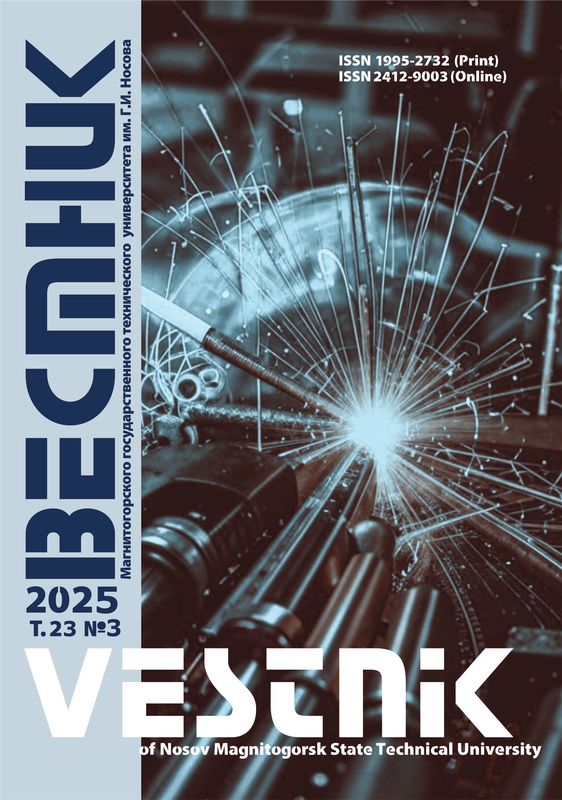Abstract
Problem Statement (Relevance): When determining the load capacity of large size pressure couplings it seems to be a common practice to only account for the friction factor while overlooking the microtopography of mating surfaces or their structure or mechanical properties. However, in the case of composite mill rolls these characteristics may have a considerable impact on the load capacity, the stress-strain state, the durability and, what is particularly essential, the quality of rolled products. Objectives: The authors aimed to improve the modelling technique used to simulate the hot assembly of composite mill rolls by introducing the capability to account for the microtopography and the mechanical properties of mated surfaces. Methods Appied: Finite-element modelling technique is applied for simulation of the shaft-bushing assembly. The process model consists of several interrelated submodels that simulate the behaviour of metal during deformation at different scale. The macro model represents the metal as an isotropic material. It is used to obtain the values of the stress-strain state parameters on a macro level. The absolute values of the stress-strain state parameters produced by the macro model are superimposed on the micro model at each step, due to which one can simulate the distribution of the stress-strain state parameters in separate micro-structural components in any point of the roll body. A steel roll made of steel 30 with laser-hardened surface (the depth of the heated area is 50 µm, with fusion ap-plied) was used to collect microtopographic data. In addition to the microtopographic studies, the quantitative parameters of the surface layer microstructure were obtained and the key process parameters (such as the geometry of the parts, the temperature and the speeds) taken into account. Originality: The simulation helped obtain a picture showing the distribution of equivalent stresses after the roll sleeve has cooled down (the simulation roll sleeve was heated up 350°C before the assembly). The maximum stresses occur at the edges of the sleeve and at the contact area. The maximum equivalent stresses registered were 150-170 MPa on the roll surface and 772-839 MPa on the inside of the sleeve. The maximum stresses occur around the microwaves found on the roll surface after laser hardening with the stress level reaching 2190 MPa. Practical Relevance: Through validation of this method the authors were able to obtain data on the dynamics of changing stress-strain state at a microtopographic scale. The application of this approach for computer simulation of the assembly and operation of metallurgical equipment can help expand the classical design theory applicable to large size composite parts.
Keywords
Composite mill roll, computer modeling, assembly, microtopography, surface, laser hardening, stress.
1. Polukhin P.I., Nikolaev V.A., Polukhin V.P. et al. Prochnost’ prokatnykh valkov [Durability of mill rolls]. Alma-Ata: Nauka, 1984. 295 p. (In Russ.)
2. Belevskiy L.S., Firkovich A.Yu., Sudorgin I.V. et al. Sostavnye prokatnye valki: Monografiya [Composite mill rolls: Mono-graph]. Magnitogorsk: Nosov Magnitogorsk State Technical University, 2004. 206 p. (In Russ.)
3. Veyko V.P., Smirnov V.N., Chirkov A.M. Lazernaya ochistka v mashinostroenii i priborostroenii [Laser cleaning in machine building and instrument industries]. St. Petersburg: ITMO, 2013. 103 p. (In Russ.)
4. Grechishchev E.S., Ilyashchenko A.A. Soedinenie s natyagom [Pressure coupling]. Moscow: Mashinostroenie, 1981. 247 p. (In Russ.)
5. Lebed V.T. Povyshenie kachestva soedineniya krupnogabar-itnykh sostavnykh izdeliy [Improved quality of couplings in large size composite products]. Kharkov: NTU "KhPI", 2015, pp. 181–184.
6. Alekhin A.G. Povyshenie nagruzochnoy sposobnosti soedi-neniy s natyagom na osnove lazernoy zakalki: Avtoref. dis. k-ta tekhn. nauk [Enhancing the load carrying capacity of pres-sure coupling by laser hardening: Extended abstract Ph.D. dissertation]. Volgograd, 2004. 18 p. (In Russ.)
7. J. Kusiak, D.Szeliga, L. Sztangret. Modelling techniques for optimizing metal forming processes. Microstructure Evolution in Metal Forming Processes. 2012, pp. 35–66.
8. M.H.A. Bonte, A.H. Van Den Boogaard, J. Huétink. A metamodel based optimisation algorithm for metal forming processes. Advanced Methods in Material Forming. 2007, pp. 55–72.
9. K. Saanouni, P. Devalan. Damage Mechanics in Metal Form-ing: Advanced Modeling and Numerical Simulation. Springer, 2013. 523 p.
10. E.A. De Souza Neto, D. Perić, D.R.J. Owen. Computational Methods for Plasticity: Theory and Applications. John Wiley & Sons, Ltd, 2008. 791 p.
11. A. Bertram, G. Risy, T. Böhlke. On different strategies for micro-macro simulations of metal forming. Micro-Macro-interaction: In Structured media and Particle Systems, Springer Berlin Heidelberg, 2008, pp. 33–39.
12. R. De Borst. Challenges in computational materials science, multiple scales, multiphysics and evolving discontinuities. Computational Material Science. 2008, no. 43, pp. 1–15.
13. Konstantinov D.V., Korchunov A.G. Multi-scale computer simulation of metal forming processes. Vestnik Magnitogorskogo Gosudarstvennogo Tekhnicheskogo Universiteta im. G.I. Nosova [Vestnik of Nosov Magnitogorsk State Technical University], 2015, no.1 (49), pp. 36–43. (In Russ.)
14. Korchunov A.G., Konstantinov D.V. On reconstruction of a real metal microstructure in metal forming processes simula-tion. Aktualnye problemy sovremennoy nauki, tekhniki i obra-zovaniya [Important problems of modern science, technology and education], 2014, no. 1, pp. 117–121. (In Russ.)
15. Konstantinov D.V., Bzowski K., Korchunov A.G., Pietrzyk M. Modeling of axisymmetric deformation processes allowing for the metal microstructure. Kompyuternye issledovaniya i mod-elirovanie [Computer Research and Modeling], 2015, no. 4, pp. 897–908. (In Russ.)












